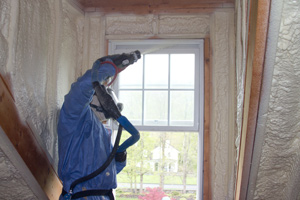In Business Since | License #
In Business Since | License #


Better than batts. The closed-cell spray foam being applied here outperforms fiberglass batt insulation in several ways. It has much higher R-value. It seals air leaks while also insulating. It won’t compress, settle or be damaged by moisture.
Spray foam insulation is in the news a lot these days. With energy costs on the rise, people are paying more and more for heating and cooling. Maintaining comfortable interior temperatures demands electricity, gas and fuel oil to run HVAC equipment –furnaces, boilers, heat pumps and air conditioners.
Most homeowners understand that improving home insulation is a surefire way to cut the cost of heating and cooling, and that’s where spray foam comes in. While homeowners consume spray foam in the form of small pressurized cans available an home centers and hardware stores, foam insulation contractors are busy doing large-scale spray foam operations –filling the spaces between studs, joists and rafters with the insulation that expands on contact.
Is spray foam a good choice to improve your home energy performance? Dr. Energy Saver can inspect and evaluate insulation and airtightness levels at your house and provide the right energy-saving solutions. Call or email for a free evaluation and insulation estimate today.
There are different kinds of spray foam, and many people are confused about the differences between open-cell foam and closed-cell foam.
Like its name suggests, open-cell foam is made up of tiny bubbles that are interconnected. The bubbles hold air, which provides insulation value –typically between R-3.5 and R-4 per in.
Like closed-cell foam, open-cell foam expands to fill gaps and cracks as soon as it’s applied. But instead of curing to a hard, smooth-surfaced mass, closed-cell foam has a spongier feel. And like a sponge, it will absorb moisture. Since insulation loses R-value when wet, it’s not advisable to use open-cell spray foam in damp environments like basements and crawl spaces. It can be sprayed between rafters or studs, but its low R-value won’t provide much total insulation value in a confined space. Open-cell foam is usually less expensive to install that closed-cell foam.
Canned foam like GREAT STUFF™ is a closed-cell foam that comes in “single-component” form. The closed-cell foam that contractors use on large-scale spray foam jobs is also known as “two-component” foam or polyurethane foam. Two chemical compounds are blended together at the application nozzle, causing the expanding foam reaction.
Even though it’s more expensive to install than open-cell foam, closed-cell foam is often preferred for insulation projects because it offers higher R-value –between R-6 and R-7.1 per in.; and because it forms an effective moisture barrier. The ability to block moisture transmission while also providing air sealing and high insulation value is an advantage in many applications.
Interested in the benefits that spray foam can bring to your home? Dr. Energy Saver is the leading provider of spray foam insulation across the country. Our technicians are trained and certified to get the job done right. Contact your local dealer today!
Looking for a price? Get a no cost, no obligation free estimate.